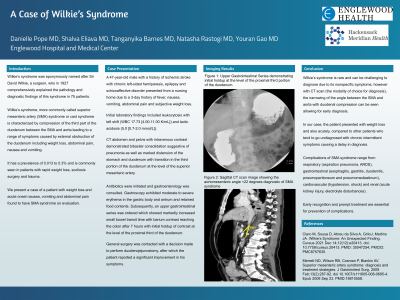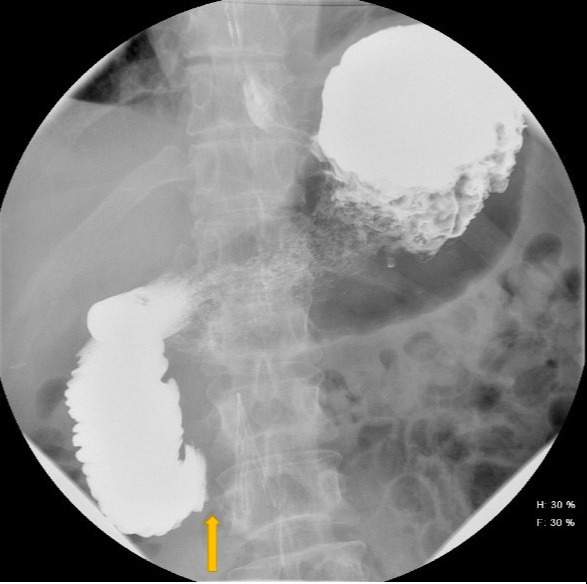Sunday Poster Session
Category: Small Intestine
P1299 - A Case of Wilkie's Syndrome
Sunday, October 22, 2023
3:30 PM - 7:00 PM PT
Location: Exhibit Hall

Has Audio

Danielle Pope, MD
Englewood Hospital and Medical Center
Englewood, NJ
Presenting Author(s)
Danielle Pope, MD, Shalva Eliava, MD, Chelsey Bertrand-Hemmings, MD, Tanganyika Barnes, DO, Youran Gao, MD, Natasha Rastogi, MD
Englewood Hospital and Medical Center, Englewood, NJ
Introduction: Wilkie’s syndrome, more commonly called superior mesenteric artery (SMA) syndrome or cast syndrome is characterized by compression of the third part of the duodenum between the SMA and aorta leading to a range of symptoms caused by external obstruction of the duodenum including weight loss, abdominal pain, nausea and vomiting. It has a prevalence of 0.013 to 0.3% and is commonly seen in patients with rapid weight loss, scoliosis surgery and trauma. We present a case of a patient with weight loss and acute onset nausea, vomiting and abdominal pain found to have SMA syndrome on evaluation.
Case Description/Methods: A 47 year old male with a history of ischemic stroke with chronic left-sided hemiparesis, epilepsy and schizoaffective disorder presented from a nursing home due to a 3 day history of fever, nausea, vomiting, abdominal pain and subjective weight loss. Initial laboratory findings included leukocytosis with left shift (WBC 17.73 [4.00-11.00K/mL]) and lactic acidosis (5.0 [0.7-2.0mmol/L]). CT abdomen and pelvis with intravenous contrast demonstrated bibasilar consolidation suggestive of pneumonia as well as marked distension of the stomach and duodenum with transition in the third portion of the duodenum at the level of the superior mesenteric artery. Antibiotics were initiated and gastroenterology was consulted. Gastroscopy exhibited moderate to severe erythema in the gastric body and antrum and retained food contents. Subsequently, an upper gastrointestinal series was ordered which showed markedly increased small bowel transit time with barium contrast reaching the colon after 7 hours with initial holdup of contrast at the level of the proximal third of the duodenum . General surgery was contacted with a decision made to perform duodenojejunostomy, after which the patient reported a significant improvement in his symptoms.
Discussion: Wilkie’s syndrome is rare and can be challenging to diagnose due to its nonspecific symptoms, however with CT scan (the modality of choice for diagnosis), the narrowing of the angle between the SMA and aorta with duodenal compression can be seen allowing for early diagnosis. In our case, the patient presented with weight loss and also acutely, compared to other patients who tend to go undiagnosed with chronic intermittent symptoms causing a delay in diagnosis. Early recognition and prompt treatment are essential for prevention of complications such as dehydration and malnutrition.

Disclosures:
Danielle Pope, MD, Shalva Eliava, MD, Chelsey Bertrand-Hemmings, MD, Tanganyika Barnes, DO, Youran Gao, MD, Natasha Rastogi, MD. P1299 - A Case of Wilkie's Syndrome, ACG 2023 Annual Scientific Meeting Abstracts. Vancouver, BC, Canada: American College of Gastroenterology.
Englewood Hospital and Medical Center, Englewood, NJ
Introduction: Wilkie’s syndrome, more commonly called superior mesenteric artery (SMA) syndrome or cast syndrome is characterized by compression of the third part of the duodenum between the SMA and aorta leading to a range of symptoms caused by external obstruction of the duodenum including weight loss, abdominal pain, nausea and vomiting. It has a prevalence of 0.013 to 0.3% and is commonly seen in patients with rapid weight loss, scoliosis surgery and trauma. We present a case of a patient with weight loss and acute onset nausea, vomiting and abdominal pain found to have SMA syndrome on evaluation.
Case Description/Methods: A 47 year old male with a history of ischemic stroke with chronic left-sided hemiparesis, epilepsy and schizoaffective disorder presented from a nursing home due to a 3 day history of fever, nausea, vomiting, abdominal pain and subjective weight loss. Initial laboratory findings included leukocytosis with left shift (WBC 17.73 [4.00-11.00K/mL]) and lactic acidosis (5.0 [0.7-2.0mmol/L]). CT abdomen and pelvis with intravenous contrast demonstrated bibasilar consolidation suggestive of pneumonia as well as marked distension of the stomach and duodenum with transition in the third portion of the duodenum at the level of the superior mesenteric artery. Antibiotics were initiated and gastroenterology was consulted. Gastroscopy exhibited moderate to severe erythema in the gastric body and antrum and retained food contents. Subsequently, an upper gastrointestinal series was ordered which showed markedly increased small bowel transit time with barium contrast reaching the colon after 7 hours with initial holdup of contrast at the level of the proximal third of the duodenum . General surgery was contacted with a decision made to perform duodenojejunostomy, after which the patient reported a significant improvement in his symptoms.
Discussion: Wilkie’s syndrome is rare and can be challenging to diagnose due to its nonspecific symptoms, however with CT scan (the modality of choice for diagnosis), the narrowing of the angle between the SMA and aorta with duodenal compression can be seen allowing for early diagnosis. In our case, the patient presented with weight loss and also acutely, compared to other patients who tend to go undiagnosed with chronic intermittent symptoms causing a delay in diagnosis. Early recognition and prompt treatment are essential for prevention of complications such as dehydration and malnutrition.

Figure: Upper Gastrointestinal Series demonstrating initial holdup at the level of the proximal third portion of the duodenum (yellow arrow)
Disclosures:
Danielle Pope indicated no relevant financial relationships.
Shalva Eliava indicated no relevant financial relationships.
Chelsey Bertrand-Hemmings indicated no relevant financial relationships.
Tanganyika Barnes indicated no relevant financial relationships.
Youran Gao indicated no relevant financial relationships.
Natasha Rastogi indicated no relevant financial relationships.
Danielle Pope, MD, Shalva Eliava, MD, Chelsey Bertrand-Hemmings, MD, Tanganyika Barnes, DO, Youran Gao, MD, Natasha Rastogi, MD. P1299 - A Case of Wilkie's Syndrome, ACG 2023 Annual Scientific Meeting Abstracts. Vancouver, BC, Canada: American College of Gastroenterology.
